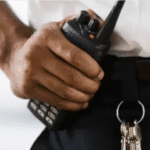Getting The Message
Reliable and timely communication for a church security team is critical to ensure the effectiveness of the team. Team members must be able to disseminate information during “non-duty hours” for rosters, schedule changes, relevant training opportunities, and more. However, for this topic we want to focus on technologies and devices your team may use while providing physical security during church activities such as during weekend services, mid-week evening activities, special events, etc. Specifically hand-held, portable options to provide reliable, instantaneous, discrete communications while “on-duty”. Team needs will vary based on the size of the team, the size of the congregation, and the layout of the physical facility. There is no “one solution fits all,” so we will discuss some possible solutions to assist you in selecting a technology (or a combination of technologies) to meet your needs.
In our modern world, most people own a smartphone. It typically offers internet access, data storage, email, and text message capability. These options can provide near instantaneous, discrete communications among team members. Additional apps such as GroupMe and other “walkie-talkie” apps can provide additional group messaging functionality. These options are inexpensive to implement and maybe all you need for your team assuming all team members are receiving sufficient cell coverage or can connect via wireless internet access (WiFi). Handheld two-way radios are another commonly used technology. Some of these also have an earpiece option that ensure the communications are only heard by team members. While there are numerous brands and models which offer various features and capabilities, they basically provide the ability to transmit and receive voice communications. The initial investment may be more costly than using existing smartphones, but their primary advantages are the speed of communications and the instantaneous notification that they provide to all team members. This is especially useful if you have a relatively large size team (6 persons or more) distributed throughout a relatively large campus. Team members can quickly press the push-to-talk (PTT) button and transmit to all team members requesting assistance or providing valuable intel to everyone. For example, team members may be alerted through a voice transmission of a suspicious person on the premises or maybe a BOLO has arrived at your facility. If an encounter between a team member and a visitor to your facility unexpectedly deteriorates into a physical confrontation, it will be reasonably easy for the team member to “key the radio” (pressing PTT) and call for help even if only one hand is available. There are drawbacks because radios do have an effective range which may not meet the distance requirements for your team. Also, some construction materials in your buildings may “drown-out” the radio signals. This technology, like any technology, should be thoroughly tested in your operational environment to understand its strengths and weaknesses.
Some teams use a combination of these technologies. While the primary communication technology is the hand-held, two-way radio, a team may also send communications via a phone app that are not as time sensitive such as a new BOLO message, a discretely taken photo of a suspicious person, a roster of those presently on duty, current assignments, etc.
You should assess your own team’s needs for communications by experimenting with a couple of options and select the technology or technologies that meet your operational requirements.

